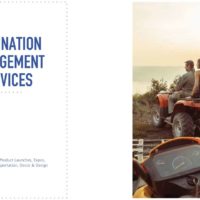For the time being, most states have prohibited gatherings of more than 10 people. But conference venues and convention centers are readying for when those restrictions will be lifted and events can resume.
Venues such as the Monterey Conference Center and the Palm Springs Convention Center in California have updated their layouts to account for social distancing. The new models showcase a way forward for the events industry and can help assuage the health concerns of speakers, sponsors and attendees.
“We understand the desire and the need for face-to-face meetings and to that end, our team has put together our health and safety promise,” said Rob Hampton, general manager of the Palm Springs Convention Center in a 12-minute video that walks viewers thorough all the changes the venue has made. “It is designed with information from the World Health Organization, the Centers for Disease Control and Prevention, government mandates and guidelines outlined in the venue shield program from ASM Global. The health and safety of our clients, meeting attendees and supplier partners is of the utmost importance.”
Nearly every aspect of the live event experience must be rethought in light of the COVID-19 pandemic, from seating in the banquet halls and meeting rooms to the setup up of sponsor booths and meal stations. In addition to these updates, the Monterey Conference Center is planning to launch training sessions later this month that will help local hospitality partners and vendors prepare for hosting meetings in the near future.
“We’re in the last of the reopening phases, so we anticipate that we’re going to open by mid-September; but in the interim, I needed something for our guys to do,” said Doug Phillips, general manager of the Monterey Conference Center. “I thought what better way to bring value to our community and the hospitality industry than to repurpose the space for COVID-19 training?”
Following are some of the changes the venues have made that meeting planners can expect to encounter when in-person gatherings resume.
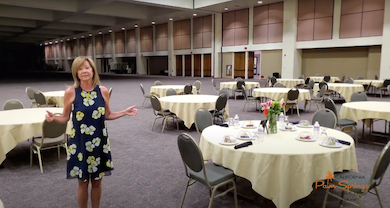
Reduced Room Capacities
The Palm Springs Convention Center has adjusted its banquet tables to seat four attendees each.
The Palm Springs Convention Center has adjusted its banquet tables to seat four attendees each. Photo Credit: Palm Springs Convention Center
Whether it be a banquet, lecture or keynote, one thing is for sure: Room capacities will need to be reduced in order to uphold proper social distancing.
Fortunately, in the case of banquet style seating, the spacing between tables will likely not need to be changed by much. The number of available seats per table, however, will have to be reduced.
“Our tables are set seven feet apart right now, which really is not very different from what you would see in a typical banquet setting,” said Kristie Dore, director of conference services at the Palm Springs Convention Center, in the venue’s health and safety update video. “Our current fire regulations require us to set our tables six feet apart, so really we’ve only increased our distance by one foot so that we have that distancing between chairs.”
According to Dore, the biggest different planners can expect is fewer chairs at each table. The Palm Springs Convention Center, for example, has adjusted its seating layout to accommodate four attendees per table — down from 10 seats normally.
Seating capacities for keynote and breakout sessions must also be adjusted. Traditionally, lecture-style seating would allow more guests to be fit into the room, while classroom-style seating was better suited for more intimate breakout sessions. However, Dore explains, the number of chairs used for either layout is now essentially the same, due to social-distancing requirements.
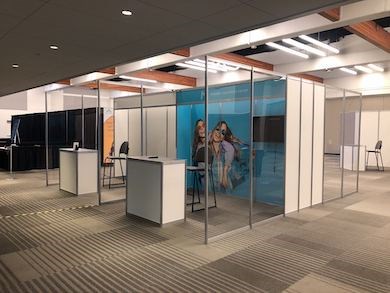
Socially Distanced Sponsor Booths
Monterey-Conference-Center-Social-Distancing-Sponsor-Booths-Coronavirus-Events
Using plexiglass walls between sponsor booths can help increase capacities while keeping guests safe. Photo Credit: Monterey Conference Center
The traditional exhibition hall filled with crowds of people and swag bags at every table will cease to exist, at least for now and in the immediate post-COVID-19 world to come. But event organizers can still set up a socially distanced exhibition hall. According to Phillips of the Monterey Conference Center, there are a few options to choose from.
The simplest is to space the sponsor booths at least six feet apart on all sides. But doing so can reduce capacity by about 75 percent, says Phillips, and make it hard for event organizers to turn a profit.
Another option is to set up plexiglass walls around the booths. “If you do that, you don’t lose space and you can increase the capacities by about 50 percent. So instead of losing 75 percent, we only lose about 25 percent of the space,” he said. But there is one caveat: The plexiglass walls are more expensive to produce.
Whichever option planners choose, they must also consider the flow of the space. To reduce the risk for overcrowding, Phillips suggested assigning time slots for attendees to visit the exhibition hall and creating a clear walking path for guests to follow.
“It needs to be regulated as much as possible so we keep the number of people in a space down,” Phillips continued. “We’re coming up with new ideas and thoughts to present to our meeting planners to let them choose what works best for them.”
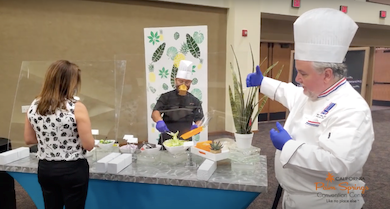
Shielded F&B Service
Palm-Springs-Conference-Center-Food-Beverage-Coronavirus-Events
Plexiglass walls can also be installed at food stations to create a barrier between guests and staff. Photo Credit: Palm Springs Convention Center
Buffets too will be a thing of the past, replaced by prepacked meals or shielded food service stations.
“The biggest challenge in the food-and-beverage area is that it has to be served, not self-served,” said Phillips. But this doesn’t just include the food. Changes must also be made to the cutlery and condiments so that there is no risk of cross contamination among attendees.
One way the Palm Springs Convention Center is tackling this issue is by creating shielded service stations. Executive chef Brad Toles showed off four such stations to staff in the venue’s health and safety video.
The four stations served customizable salads, warm entrees, coffee and condiments. A plexiglass wall separates guests from staff members, who wear masks and gloves and can prepare whatever meal the guests asks for. Once ready, the food is covered and moved to a pickup station so there is no contact between employees and guests.
Another option is to serve three-course meals which arrive at the tables “domed,” or covered in a plastic top. “The domes are here from the time we plate it up to the time we preset it, so the food is completely protected using this system,” said Toles. He also suggested that salads and dessert be preset, so only the entrée needs to be served during the meal.
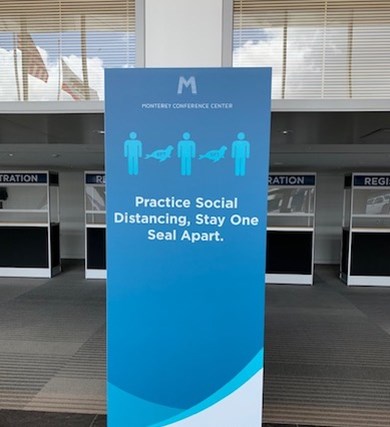
Signage at Every Turn
Monterey-Conference-Center-Social-Distancing-Sign-Coronavirus
Venues can get creative with signage that honors their surroundings. Photo Credit: Monterey Conference Center
One thing that every event will need is ample signage to encourage social distancing, direct traffic flow and remind attendees of the health standards and expectations, such as frequent hand washing and the use of masks.
Signage should be spread out across the venue. The Monterey Conference Center, for example, has signs posted at all entrance doors and exits, at the registration tables, on the floors of the exhibit hall and even on the escalators.
When it comes to signage, you can almost never have enough, says Phillips. But that doesn’t mean the signs have to be simple or boring. A creative sign at the Monterey Conference Center, which sits on the waterfront overlooking the Monterey Bay, tells guests to “Practice social distancing and stay one seal apart.”
“it’s really about providing people with reminders,” said Phillips. “At this point, it’s been three months. We get it. We know that if we want to protect ourselves and our community, we have to do these things. But it’s always important to get reminded.”
